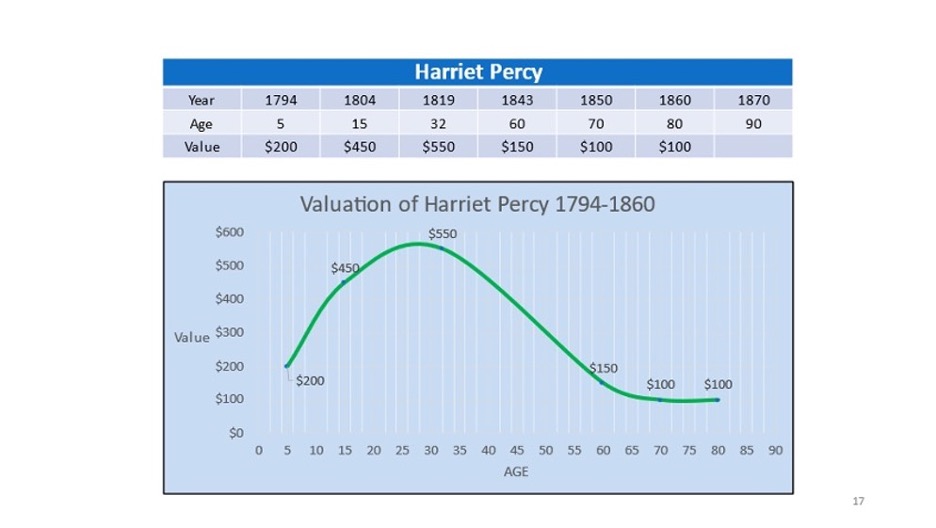On June 11, 2022 I presented Black Families of Edgefield Plantation: The Growth of Human Capital, Labor, and Wealth in Woodville, Mississippi, 1776-1865 at the Sons and Daughters of the US Middle Passage (SDUSMP) 5th Annual Juneteenth Conference. The theme of the conference was The Economic Impact of Slavery. It presented an opportunity to analyze some of the wealth and financial profits made on the Edgefield plantation from its beginning until emancipation in 1865, and to understand it from the perspective of the enslaved families who were forced to work on the plantation for life.
The young children enslaved on Edgefield started to labor in the cotton fields at around 14 years old. They reached their highest capital value to the owners – $600 for women, $800 for men – between the ages of 20-45 years old. The young women usually were paired with husbands and had their first child at around 17 years old. The value assigned to the women declined after their child-bearing years were over, around age 45. The value of the men was closely tied to their health which, after years of hard labor and poor living conditions, began to decline about 45 years until death.

Harriet is listed as five years old in the 1794 will of Charles Percy. She was the oldest child born to Christmas (born @1739) and Phebe (born @1764). Her brothers and sisters were Hector, Sampson, Mary Louise, Sally, and Phillis.
In 1819, Harriet is listed with her husband Dick Percy, who was born in 1779 in Woodville. Dick was the son of Hamlet Percy (born @1744) and Sal (born @1764). Hamlet Percy was likely captured and brought to the United States from the Igbo Nation in Nigeria.

Dick and Harriet’s children were Sall (b@1804), Rose (b@1807), Celeste (b.@1809), and Jane (b@1812), Hamlet (b.@1815), Ned (b@1825), Claiborne (b@1828), and Catish (b@1830). Dick Percy died around 1830 in Woodville.
In the 1843 J C Patrick inventory, Harriet, as head of the family, is listed as 60 years old. Her age as listed is 9 years more than expected, based on previous documents. (Note: The shift in age is not uncommon when there is a transfer of plantation owners, and most importantly depends on who is recording the inventory and who is telling the recorder the ages of the person).
The 1850 and 1860 slave schedules of J.C. Patrick, the slaveowner, does not list enslaved individuals by name – it only lists their age, sex, and race. But there is only one female who is 70 in 1850 and one female who is 80 in 1860, so I believe this is likely Harriet. I have listed a value of $100 for her for 1850 and 1860 based on the normal value assigned to enslaved individuals of that age. By 1870, on the Wilkinson County, Mississippi population census, Harriet is living with her son Ned and his wife Sophia. Harriet likely died in Woodville between 1870 and 1880, having lived 76 years in slavery on the Edgefield Plantation.

The Life of Harriet Percy
The story of the Black Families of Edgefield was started with strong, inspiring support from the family oral history, but no stories were passed down to me about Harriet Percy. Her life as one of the members of the early Edgefield community is so well-documented in the records that I can tell much of her story.
Her parents, Christmas and Phebe, were among the first Africans brought into Mississippi by Charles Percy. Her father died around 1802 after the birth of her youngest sister Phyllis. Her mother Phebe died some time before 1819. Her husband Dick Percy died around 1830 at around 50 years old, around the time that her last child was born. Harriet lived another 50 years, long enough to be listed in the 1870 census. She was the connecting link to the early families of Edgefield, her life having bridged a 100-year history. Harriet died between 1870 and 1880, at around 90 years old. She was emancipated at the end of her life, after 76 years in slavery.

The study of the records of Harriet Percy’s life has led to a better understanding of the life of an early enslaved woman in Mississippi – not as a slave, but as a mother, wife, a grandmother many times over, and now a beloved ancestor. After emancipation in 1865, hopefully she was able to live out the rest of her life and was taken care of and revered by her family and community. Harriet was a beloved elder of the Edgefield community whose story will always be remembered.

I hope she did too.
That was a nice trail of records you found to build her story!
Thanks Kristin.
I’m a visual person, so I love your graphics supporting your research. Your research and recognition of Harriet is inspiring.
Thanks Sandra. I am so glad you can relate to the charts and graphs. In lieu of personal photos, the charts convey the way I see the life of Harriet unfolding over her 90 years.
Very interesting and informative. Did Charles Percy also have a son named Robert Percy? If so, it would be interesting to see Charles Percy’s division of his estate to Robert. I think my families are
descendants of Robert Percy.
Thanks Gwen. Charles Percy’s son Robert Percy was from a marriage in England before he moved to Wilkinson County. Robert Percy and his descendants owned Beech Grove and other plantations in Louisiana.
Fantastic story and great research on the ancestor during that time in history.
Thanks for reading Marlene.
Hetepu mi Brother! Ohhhooo them Igbo nation people! Never forget reading where some enslavers write “don’t bring no Iboes” when ordering traffickers in Afrikan captives in Africa for chattel enslavement in the south!
The reason stated was “Iboes are rebellious!”
My person is moving to push for historical marking of sites here in plantation Natchez Mississippi that designate where our first Afrikans Foreparents and Ancestors were held in chattel slavery captivity here!
Prince Abdul Rahman Ibrahim great grandson, Dr. Artemus Gaye new book reflected that Afrikan captives held in chattel enslavement in early colonial times in the Natchez region were of the Igbo, Fulani and Bambara Nations!
As ya know there were a great deal of blood lines relationships among these and other migrating Nations in West Africa (problema for genealogy studies).
But for what mi is moving to do now about our first Afrikans Ancestors and Foreparents sites of enslavement starting with the French invaders of the Natches (Indians) Nation, mi is so pleased to be able to point out the Cultural Nations known, without doing a lot of searching!
This means that certain cultural activities were present in New Orleans, they were not and are not exclusive!
I knew you would be interested in this one sample record documenting the Igbo people in Natchez Court Records intersecting with my personal family/ community history. And yes, the whole region from Natchez to New Orleans contains the records of the influx of people from the Nations of West Africa. Thanks for reading.
If at all possible,were there any Clayton’s,Rattlers or Johnson on the Plantation
No I did not see those surnames on early Edgefield.
Great research. I, too, found the diagram to be helpful with visualizing the timeline. Thank you so much for honoring Harriet.
Thanks Melissa.
Great work! It’s not easy being able to track people over that timeframe. You were fortunate with all the probate records. Good luck with your research.
Thanks Sally. The real key to unlocking these continuous probate records was that although the plantation passed down to different slaveowners, the enslaved African families stayed there for over 100 years.
I appreciated reading Harriet’s story and the way you researched her family and presented the line. Thanks for sharing it.
Thanks Denise.